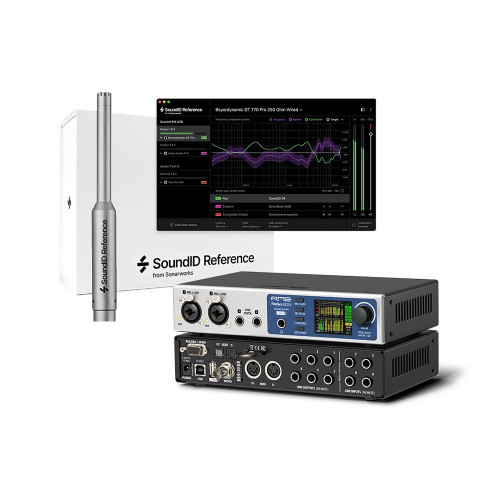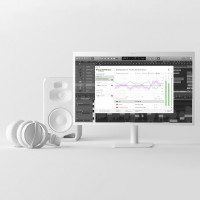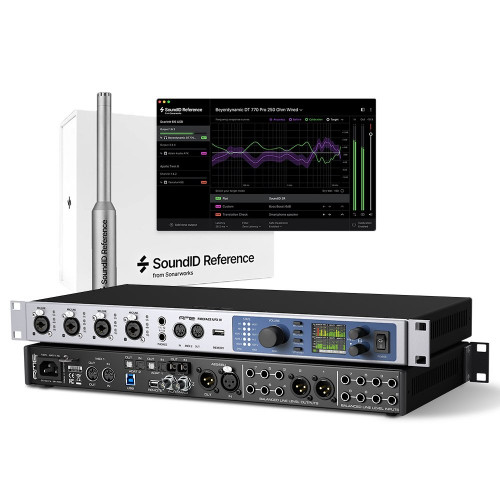Description
RME Fireface UCX II + Sonarworks Official Bundle
Ready to take your mixes to the next level?
Now you can purchase the incredible RME Fireface UCX II together with Sonarworks SoundID Reference for Stereo software – complete with a calibrated measurement microphone!
Once you've exported your SoundID profile from Sonarworks' award-winning room correction software, you'll be able to load it directly into RME’s advanced Room EQ feature.
Elevate your audio experience like never before with precise Room Calibration tools on up to 20 audio channels - 9-band PEQ, Delay, Volume Calibration and Crossfeed - all powered by your RME audio interface’s on-board DSP (so zero added strain on your Mac or PC!).

Say goodbye to unwanted resonances and hello to your new finely-calibrated monitoring environment.
Note: We are the official UK distributor for RME Audio. This is a UK-only initiative fulfilled by us (Synthax Audio UK), and is open to UK residents only. You must have a UK delivery address to take advantage of this deal.
RME Fireface UCX II - 40-Channel, 192 kHz
Advanced USB Audio Interface
The Fireface UCX II is a highly integrated pro audio solution in an ultra-compact format. Designed for use in studio and live recording, the UCX II continues RME's tradition of producing powerful and flexible interfaces for the professional audio market, packing the kind of connectivity and features into a half-rack size unit that is often spread over two - or even three - 19 inch panels.
With up to 20 channels recording and 20 channels playback; RME's stellar SteadyClock FS digital clocking technology; high performance microphone inputs; TotalMix FX mixing and routing software (complete with Parametric EQ and Dynamics processing on every channel, plus Echo and Reverb sends); stand-alone hard disk recording to external USB hard drives or pen drives via 'DURec' (Direct USB Recording); MIDI I/O; a powerful headphone output; and full stand-alone operation, the Fireface UCX II excels with the highest feature to space ratio ever from an RME device.
Developed in time to celebrate the company's 25th anniversary, the RME Fireface UCX II represents the culmination and refinement of 25 years of digital audio innovation.

Celebrating 25 years of RME
Throughout its 25 year history, RME has been fully committed to a principle of flexibility - the more flexible a product, the more easily it can be adapted to new requirements. For company founder Matthias Carstens, this lies at the heart of RME's success: "The Fireface UCX II makes us proud and enthusiastic as it represents a natural evolution of our product range."
"Boasting up to 20 recording and 20 playback channels, SteadyClock FS, high-performance microphone inputs, built-in parametric EQ, USB direct recording plus full stand-alone functionality, the brand-new Fireface UCX II truly represents the essence of freedom, flexibility, and passion. At present, no existing audio interface offers more connectivity and functionality in a half-rack package."
The Fireface UCX II houses two mic/line preamps in XLR combo configuration on the front panel, along with two digitally controlled line/instrument inputs, followed by a headphone jack, various control buttons, a display, and the main volume knob. At the rear is a set of ten analogue balanced line inputs and outputs, MIDI I/O, ADAT I/O, AES/EBU and SPDIF I/O, USB 2.0 as well as a switchable word clock I/O.

DURec (Direct USB Recording)
The RME Fireface UCX II is the first half-rack interface from RME to feature RME's Direct USB Recording (DURec) functionality. Previously only found on RME's Fireface UFX, UFX II and UFX+, any of the Fireface UCX II's input or output channels can be recorded directly to a
USB storage device - in any combination, up to and including all 40 channels simultaneously - via the dedicated USB port found on the back panel of the device.
Powered by the integrated DSP, DURec also enables the Fireface UCX II to be used for stand-alone recording and playback (i.e. without the need for a computer). Suggested applications include creating instantaneous backups of studio, live and rehearsal recording - acting as a fail-safe against a computer hardware failure - as well as for stand-alone field recording, or for use in virtual soundchecks (using DURec for playback of a previous night's live show recording).

Class Compliant Mode (Plug 'n' Play with an Apple iPad)
The Fireface UCX II also features a Class Compliant / Plug 'n' Play mode, enabling the interface to be used for high-quality, mulit-track recording with an Apple iPad, and providing iPad users with a full set of professional analogue I/O connections.
Additionally, the optional TotalMix FX for iPad app adds full control over the TotalMix hardware mixer, giving users the ability to create, store and load complete mixes directly from the iPad.

DC-Coupled Outputs - CV/Gate Voltage Control
Most audio interfaces are traditionally designed with what is called 'AC-coupled outputs', where capacitors are used to filter out any extreme low frequencies.
Whilst these frequencies are generally considered undesirable for audio - eating into headroom and potentially causing damage to other equipment - one instance where DC-coupling remains desirable is the world of modular synthesizers, where static or slow-moving signals are used for control over various parameters such as pitch note values or LFOs.
All of the Fireface UCX II’s line-level outputs are fully DC-coupled, allowing for the sending of control voltages (CV) or Gate information to modular synthesizers (such as the popular Eurorack and Moog/MOTM/Synthesizers.com formats) and other studio hardware.
Connectivity & Features

Click image to enlarge
Included Accessories
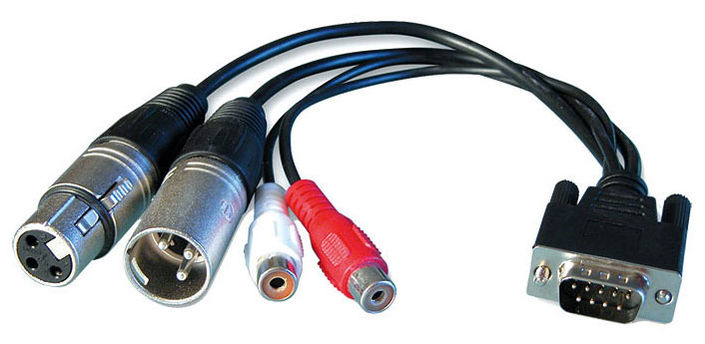
• USB 2.0 Cable, 1.8 m (6 ft)
• Optical cable (TOSLINK), 2 m (6.6 ft)
• BO968 Digital Breakout Cable (AES/EBU & SPDIF)
• External power supply with locking connector
• Power cable

RME Fireface UCX II - Overview Video
See more videos at Synthax TV
TotalMix FX & DIGICheck
The Fireface UCX II comes with the TotalMix FX DSP mixer offering comprehensive routing and monitoring options, as well as the DIGICheck Analyzer allowing to measure and analyze the digital data feed in both directions with maximum precision.
RME's DSP-based TotalMix FX mixer allows for fully independent routing and mixing of all 20 input and playback channels to all 20 physical outputs. Independent stereo submixes, plus a comprehensive Control Room section, offer unrivalled monitoring capabilities and unsurpassed routing flexibility.
Every input and output channel comes with a luxury feature set, comparable to that of a full-scale digital console. The effects per channel include 3-band parametric EQ (and adjustable Low Cut), a Dynamics section (Compressor, Expander), MS Processing and phase reversal. The Reverb and Echo effects unit is available for all channels by a stereo send and return bus, all of which is offered even at 192 kHz operation.
Latency-Free Monitoring
The complete effects section not only adds flexibility to the recording chain , but even does away with the need for an external mixer or additional latency-inducing software. Latency-free monitor mixes can be easily created - complete with EQ and Reverb - e.g. for the main studio monitors and the headphone of the vocalist(s) in the recording room.
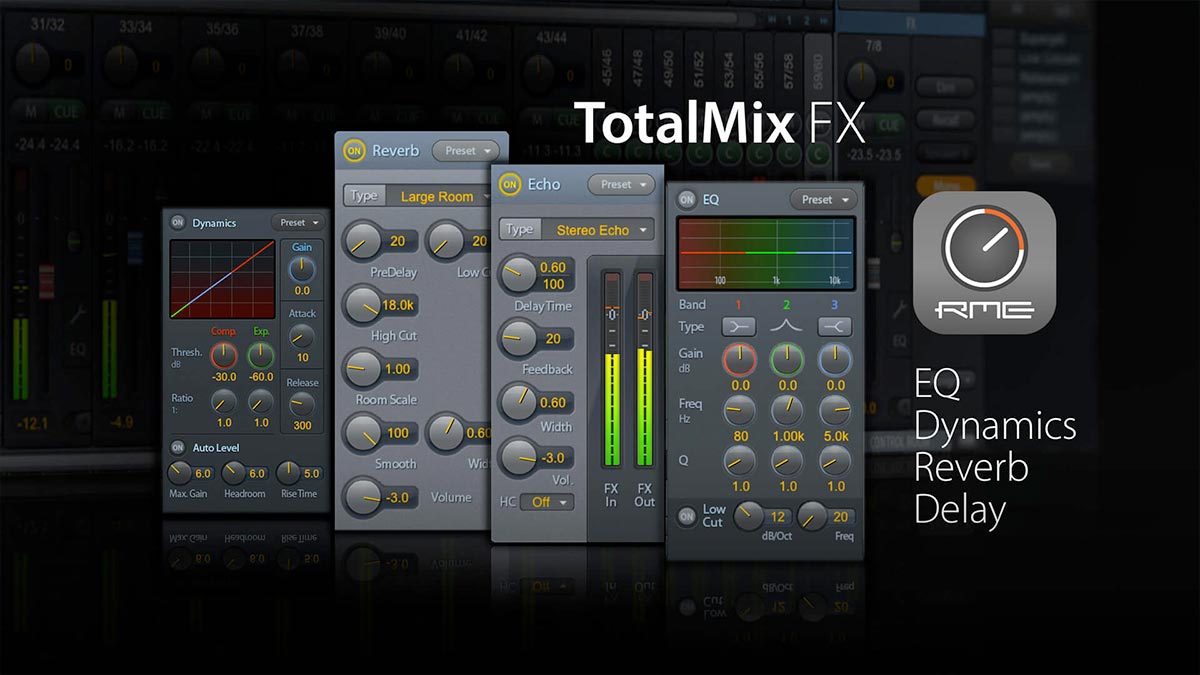
DIGICheck
RME’s DIGICheck Analyzer is a free suite of professional audio analysis tools, providing users with additional measurements digital data feed in both directions with maximum precision.
The set of tools includes comprehensive multi-channel level metering (peak and RMS); a 30-Band spectrum/frequency analyser, plus correlation meter and vectorscope; a loudness metering tool for checking against the IT 1770 / EBU R128 standards commonly found in broadcast; and a Surround Audio Scope for surround sound level metering with extended correlation analysis, ITU weighting and ITU summing.

TotalMix Remote
TotalMix Remote is a network remote control app for all RME audio interfaces and sound cards. Available as a free download via the RME website, TotalMix Remote allows for full control of the hardware mixer and effects section of the Fireface UCX II via a network-connected PC, Mac or Apple iPad, including wirelessly over Wi-Fi!
TotalMix Remote mirrors the current state of the host system on the iPad and Windows/Mac computers - the entire mixing state, the complete routing, all FX settings, up to the level meters, and everything in real-time.
TotalMix Remote supports up to three hosts with multiple interfaces each, allowing Apple's popular iPad and Windows/Mac computers to adjust all the mixer and FX settings from a distance, via Ethernet and Wi-Fi.

SteadyClock FS - FemtoSecond Clocking Technology
The RME Fireface UCX II also features RME's latest
digital clocking and jitter rejection technology, 'SteadyClock FS'. Originally developed for RME's award-winning ADI-2 Pro FS range of high-end AD/DA converters, SteadyClock FS reduces the intrinsic jitter (when converting to and from analogue over all digital formats) to a new all-time low.
All clock modes provide excellent performance and astonishingly high-quality analogue conversion, allowing you to hear your mix exactly as it is. What's more, RME's digital format conversion occurs without any loss to the signal, and SteadyClock FS ensures your sonic image will never experience any kind of degradation. This helps to optimize recordings and mixes, ensuring the soundstage is replicated to the fullest depth and clarity.

Optional: RME ARC USB (Advanced Remote Control)
The RME Fireface UCX II can also integrate with RME's optional ARC USB remote control (sold separately).
When connected to a computer's USB port (or directly to the UCX II itself via the DURec connection), the ARC USB provides users with quick access to all of the most used functions of TotalMix FX, with 15 user-definable buttons, a large encoder wheel, and a TS jack for connecting a foot switch.
The RME ARC USB is a USB 1.1 MIDI remote control - thanks to operating as a UAC 1 class device, it is natively compatible to Windows and Mac OS X. As soon as it is present in the operating system, TotalMix FX will automatically detect the ARC USB, and communicate with it via simple MIDI remote commands to control the UCX II.
Specification
General
• Power supply: external power supply
• Typical power consumption: 13 Watts
• Current at 12 Volt operating voltage: 910 mA (11 Watts)
• Dimensions incl. rack ears, full depth (WxHxD): 265 x 44 x 155 mm (10.5" x 1.73" x 6.1")
• Dimensions without rack ears, body depth (WxHxD): 215 x 44 x 130 mm (8.5" x 1.73" x 5.1")
• Weight: 910 g ( 2.0 lbs)
• Temperature range: +5° up to +50° Celsius (41° F up to 122°F)
• Relative humidity: < 75%, non condensing
Analogue
Analogue Inputs
AD, Line In 5-8, rear
• Resolution AD: 24 bit
• Signal to Noise ratio (SNR): 112 dB RMS unweighted, 115 dBA
• Frequency response @ 44.1 kHz, -0.1 dB: 5 Hz – 20.8 kHz
• Frequency response @ 96 kHz, -0.5 dB: 3 Hz – 45.8 kHz
• Frequency response @ 192 kHz, -1 dB: 2 Hz – 92 kHz
• THD: < -110 dB, < 0.00032 %
• THD+N: < -104 dB, < 0.00063 %
• Channel separation: > 110 dB
• Input: 6.3 mm TRS jack, electronically balanced
• Input impedance: 8 kOhm unbalanced, 12 kOhm balanced
• Input sensitivity switchable to +19 dBu and +13 dBu
• Variable gain: 0 to +12 dB
• Minimum level for 0 dBFS: +1 dBu, -1.2 dBV
Line In 3-4, front
As AD, but:
• Additional digital Gain stage: 0 up to +12 dB
• Maximum input level, +19 dBu, Gain 0 dB: Line +19 dBu, Inst +13 dBu
• Maximum input level, +13 dBu, Gain 12 dB: Line +1 dBu, Inst -5 dBu
• Input impedance: Instrument 1 MOhm. Line 13 kOhm balanced, 9 kOhm unbalanced
• Input Gain Inst: +6 dB
• Input mode: Line balanced (TRS), Inst unbalanced (TS)
Microphone In 1-2, front
As AD, but:
• Input: XLR, electronically balanced
• Input impedance: 5.4 kOhm
• Gain range: 75 dB
• Maximum input level, Gain 0 dB: +18 dBu
• Maximum input level, Gain 75 dB: -57 dBu
• EIN: -128 dBu A-weighted, 60 dB gain,150 Ohm, 20 Hz – 20 kHz
Line In 1-2
As AD, but:
• Input: TRS, electronically balanced
• Input impedance: 10 kOhm balanced, 5 kOhm unbalanced
• Maximum input level, Gain 0 dB: +24 dBu
• Maximum input level, Gain 75 dB: -51 dBu
Analogue Outputs
DA, Line Out 1-6, rear
• Resolution: 24 bit
• Dynamic range (DR): 112 dB RMS unweighted, 115 dBA
• Frequency response @ 44.1 kHz, -0.5 dB: 5 Hz – 20.8 kHz
• Frequency response @ 96 kHz, -0.5 dB: 5 Hz – 45 kHz
• Frequency response @ 192 kHz, -1 dB: 5 Hz - 89 kHz
• THD: < -108 dB, < 0.0004 %
• THD+N: < -104 dB, < 0.00063 %
• Channel separation: > 110 dB
• Maximum output level: +19 dBu
• Output: 6.3 mm TRS jack, servo-balanced
• Output impedance: 75 Ohm
• Output level switchable +19 dBu, +13 dBu, +4 dBu
DA - Stereo Monitor Output Phones (7-8)
As DA, but:
• Output: 6.3 mm TRS stereo jack, unbalanced
• Maximum output level at 0 dBFS, High: +19 dBu
• Maximum output level at 0 dBFS, Low: +4 dBu
• Output impedance: 1 Ohm
• Max power per channel @ 32 Ohm load, 0.1% THD: 210 mW (2.6 Vrms, +10.5 dBu)
MIDI
• 1 x MIDI I/O via 5-pin DIN jacks
• Galvanically isolated by opto-coupled input
• Hi-speed mode: Jitter and response time typically below 1 ms
• Separate 128 byte FIFOs for input and output
Digital
• Clocks: Internal, ADAT, AES, SPDIF, word clock
• Jitter suppression of external clocks: > 50 dB (2.4 kHz)
• Effective clock jitter influence on AD and DA conversion: near zero
• PLL ensures zero dropout, even at more than 100 ns jitter
• Digital Bitclock PLL for trouble-free varispeed ADAT operation
• Supported sample rates: 28 kHz up to 200 kHz
Digital Inputs
AES/EBU
• 1 x XLR, transformer-balanced, galvanically isolated, according to AES3-1992
• High-sensitivity input stage (< 0.3 Vpp)
• SPDIF compatible (IEC 60958)
• Accepts Consumer and Professional format
• Lock range: 27 kHz – 200 kHz
• Jitter suppression: > 50 dB (2.4 kHz)
SPDIF coaxial
• 1 x RCA, according to IEC 60958
• High-sensitivity input stage (< 0.3 Vpp)
• Accepts Consumer and Professional format, copy protection will be ignored
• Lock Range: 27 kHz – 200 kHz
• Jitter suppression: > 50 dB (2.4 kHz)
ADAT Optical
• 1 x TOSLINK, format according to Alesis specification
• Standard: 8 channels 24 bit, up to 48 kHz
• Double Speed (S/MUX): 4 channels 24 bit 96 kHz
• Quad Speed (S/MUX4): 2 channels 24 bit 192 kHz
• Bitclock PLL ensures perfect synchronisation even in varispeed operation
• Lock range: 31.5 kHz – 50 kHz
• Jitter suppression: > 50 dB (2.4 kHz)
Word Clock
• BNC
• Internal termination 75 Ohm switchable
• Automatic Double/Quad Speed detection and internal conversion to Single Speed
• SteadyClock guarantees super low jitter synchronization even in varispeed operation
• Not affected by DC-offsets within the network
• Signal Adaptation Circuit: signal refresh through auto-center and hysteresis
• Overvoltage protection
• Level range: 1.0 Vpp – 5.6 Vpp
• Lock Range: 27 kHz – 200 kHz
• Jitter suppression: > 50 dB (2.4 kHz)
Digital Outputs
AES/EBU
• XLR, transformer-balanced, galvanically isolated, according to AES3-1992
• Output level Professional 4.5 Vpp, Consumer 2.6 Vpp
• Format Professional according to AES3-1992 Amendment 4
• Format Consumer (SPDIF) according to IEC 60958
• Single Wire mode, sample rate 28 kHz up to 200 kHz
SPDIF coaxial
• 1 x RCA, according to IEC 60958
• Output level Professional 1.2 Vpp, Consumer 0.6 Vpp
• Format Professional according to AES3-1992 Amendment 4
• Format Consumer (SPDIF) according to IEC 60958
• Single Wire mode, sample rate 28 kHz up to 200 kHz
ADAT
• 1 x TOSLINK
• Standard: 8 channels 24 bit, up to 48 kHz
• Double Speed (S/MUX): 4 channels 24 bit 96 kHz
• Quad Speed (S/MUX4): 2 channels 24 bit 192 kHz
Word Clock
• BNC
• Max. output voltage: 5 Vpp
• Output voltage @ 75 Ohm termination: 4.0 Vpp
• Output impedance: 10 Ohm
• Frequency range: 27 kHz – 200 kHz
Product Reviews
Customer Reviews
This item currently has no reviews.






















